Competitive Strategies: Coca-Cola, McDonald's, Ford, and Honda
VerifiedAdded on 2019/10/31
|15
|3148
|401
Report
AI Summary
This report provides an in-depth analysis of competitive strategies employed by major players in the food and automotive industries. It examines the global strategies of Coca-Cola and McDonald's, focusing on differentiation, cost leadership, emerging market focus, and store enhancements. The report further explores the competitive strategies of Honda and Ford in the car industry, including their target markets, modes of entry, and responses to market demands, such as the shift towards electric vehicles in China. The analysis covers various aspects of business development, including market segmentation, product differentiation, and entry strategies, providing a comprehensive overview of competitive advantages in these dynamic sectors. The report also touches upon the importance of adapting to market trends and consumer preferences to maintain a competitive edge.
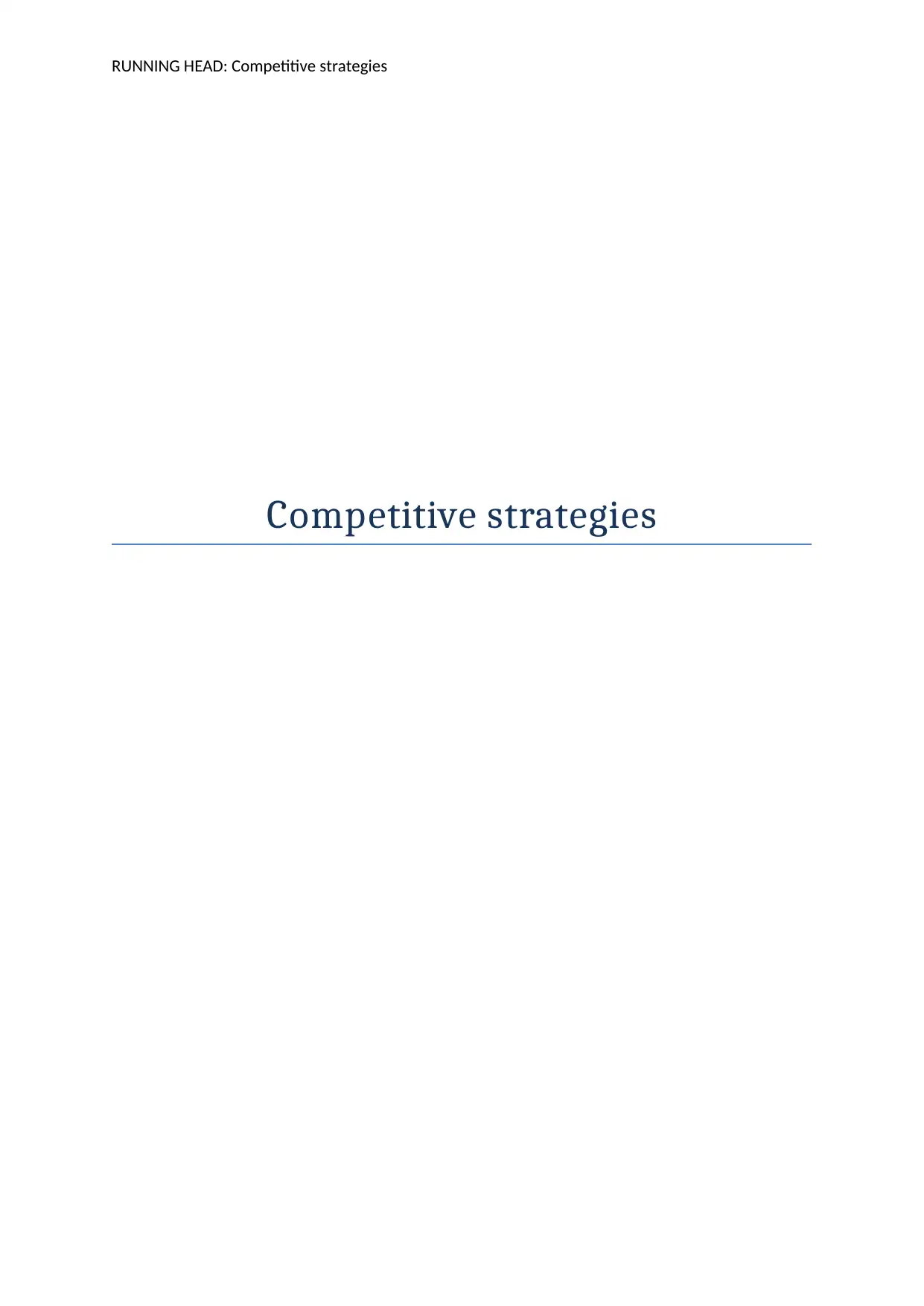
RUNNING HEAD: Competitive strategies
Competitive strategies
Competitive strategies
Paraphrase This Document
Need a fresh take? Get an instant paraphrase of this document with our AI Paraphraser
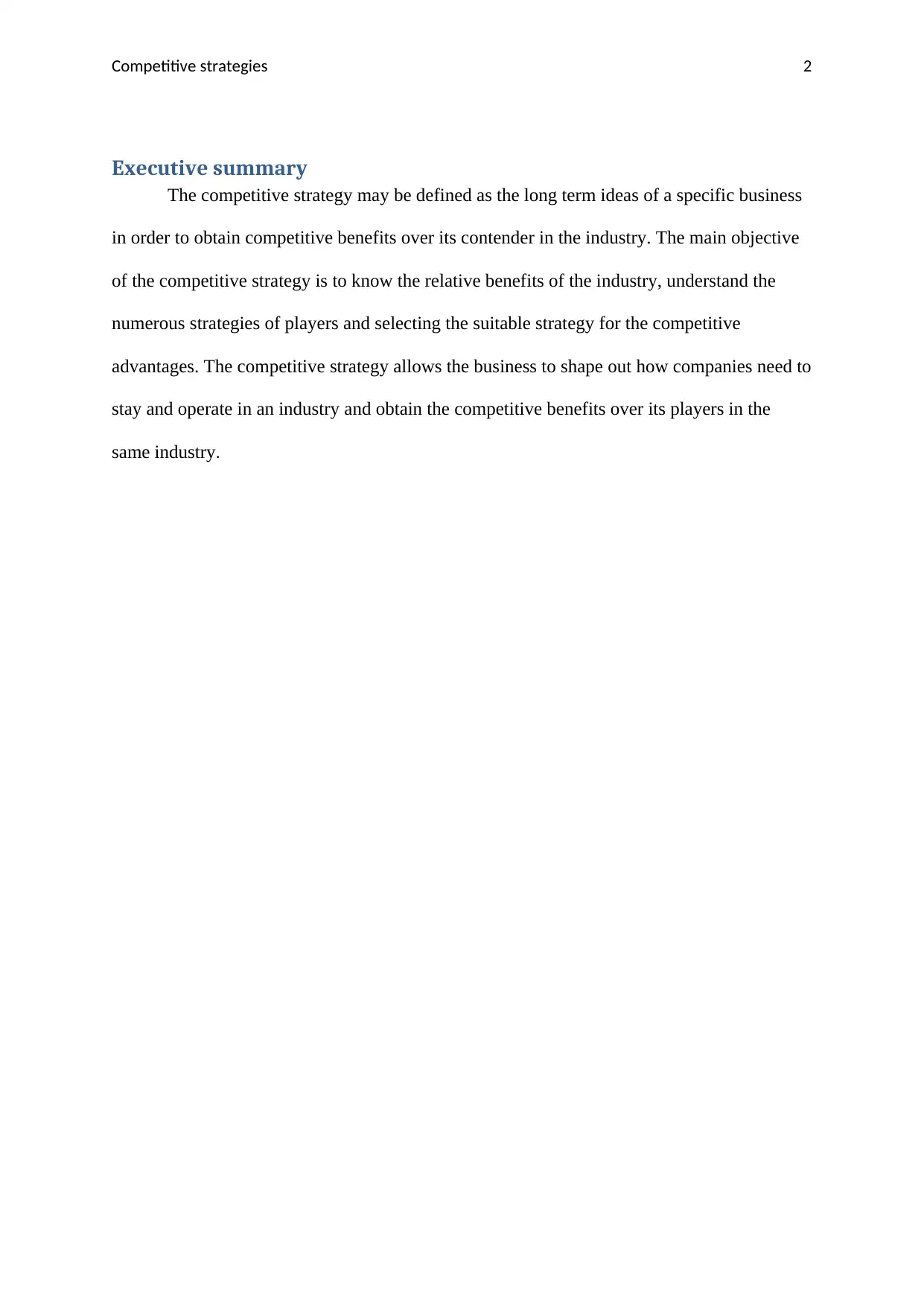
Competitive strategies 2
Executive summary
The competitive strategy may be defined as the long term ideas of a specific business
in order to obtain competitive benefits over its contender in the industry. The main objective
of the competitive strategy is to know the relative benefits of the industry, understand the
numerous strategies of players and selecting the suitable strategy for the competitive
advantages. The competitive strategy allows the business to shape out how companies need to
stay and operate in an industry and obtain the competitive benefits over its players in the
same industry.
Executive summary
The competitive strategy may be defined as the long term ideas of a specific business
in order to obtain competitive benefits over its contender in the industry. The main objective
of the competitive strategy is to know the relative benefits of the industry, understand the
numerous strategies of players and selecting the suitable strategy for the competitive
advantages. The competitive strategy allows the business to shape out how companies need to
stay and operate in an industry and obtain the competitive benefits over its players in the
same industry.
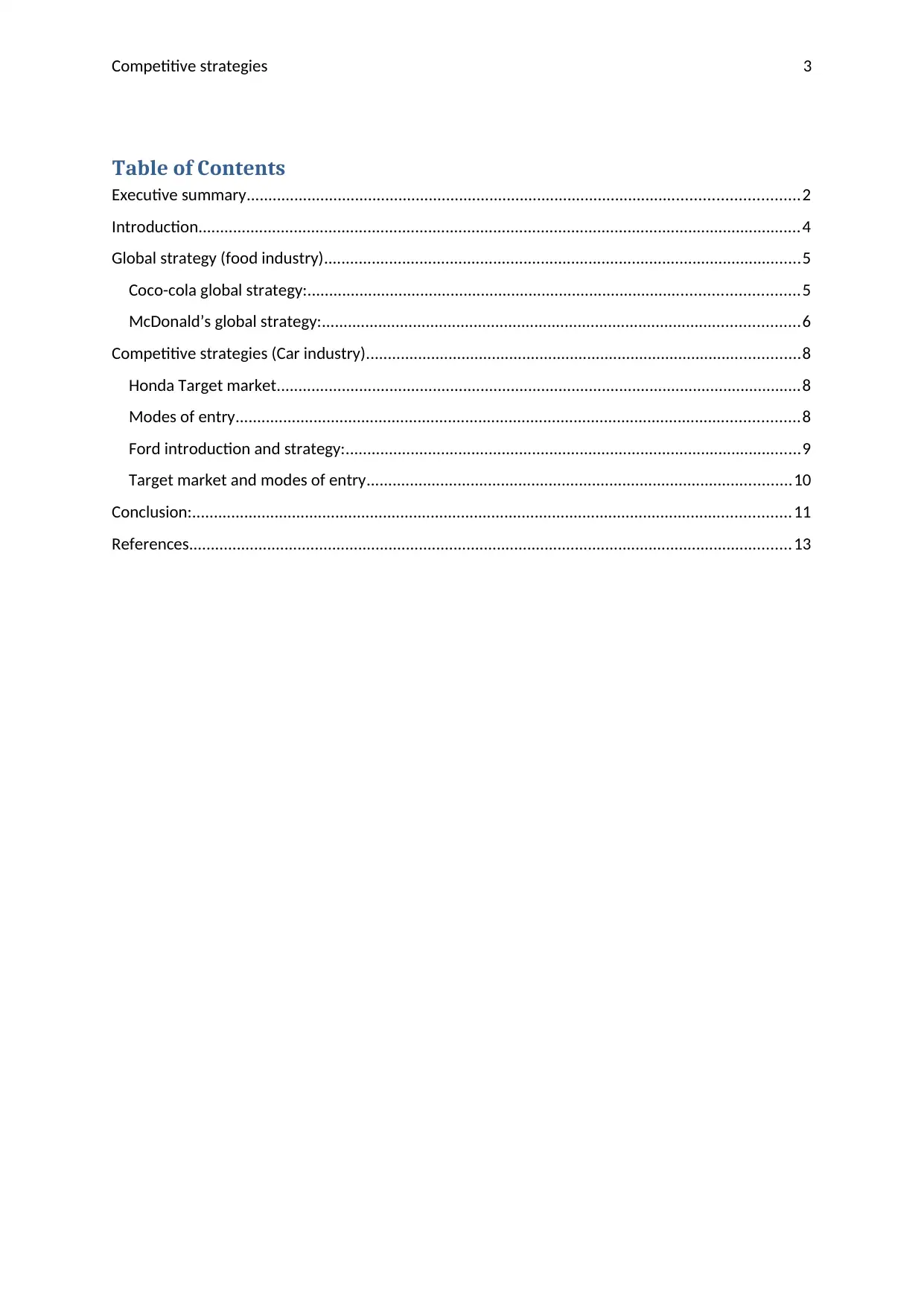
Competitive strategies 3
Table of Contents
Executive summary...............................................................................................................................2
Introduction...........................................................................................................................................4
Global strategy (food industry)..............................................................................................................5
Coco-cola global strategy:.................................................................................................................5
McDonald’s global strategy:..............................................................................................................6
Competitive strategies (Car industry)....................................................................................................8
Honda Target market.........................................................................................................................8
Modes of entry..................................................................................................................................8
Ford introduction and strategy:.........................................................................................................9
Target market and modes of entry..................................................................................................10
Conclusion:..........................................................................................................................................11
References...........................................................................................................................................13
Table of Contents
Executive summary...............................................................................................................................2
Introduction...........................................................................................................................................4
Global strategy (food industry)..............................................................................................................5
Coco-cola global strategy:.................................................................................................................5
McDonald’s global strategy:..............................................................................................................6
Competitive strategies (Car industry)....................................................................................................8
Honda Target market.........................................................................................................................8
Modes of entry..................................................................................................................................8
Ford introduction and strategy:.........................................................................................................9
Target market and modes of entry..................................................................................................10
Conclusion:..........................................................................................................................................11
References...........................................................................................................................................13
⊘ This is a preview!⊘
Do you want full access?
Subscribe today to unlock all pages.

Trusted by 1+ million students worldwide
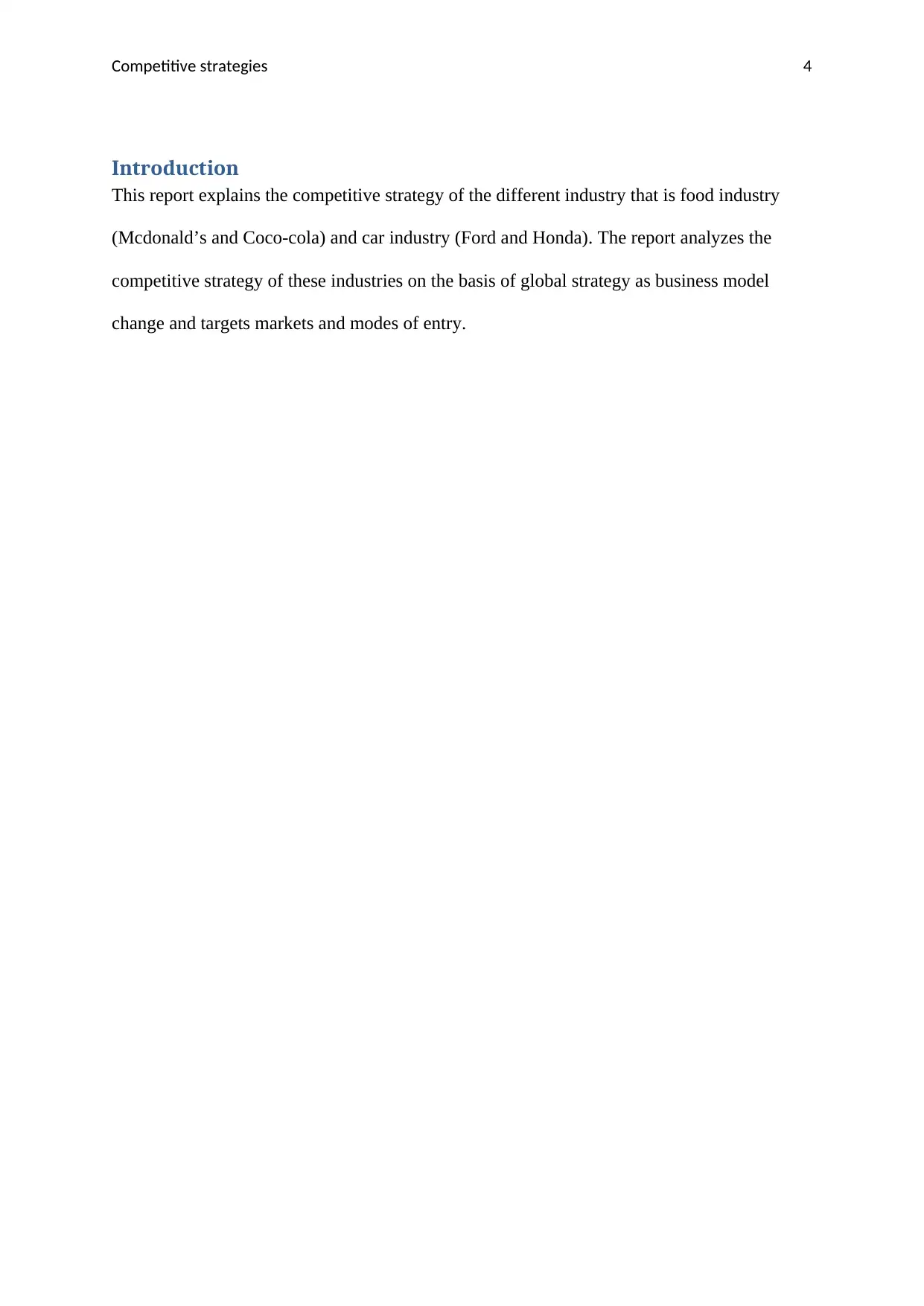
Competitive strategies 4
Introduction
This report explains the competitive strategy of the different industry that is food industry
(Mcdonald’s and Coco-cola) and car industry (Ford and Honda). The report analyzes the
competitive strategy of these industries on the basis of global strategy as business model
change and targets markets and modes of entry.
Introduction
This report explains the competitive strategy of the different industry that is food industry
(Mcdonald’s and Coco-cola) and car industry (Ford and Honda). The report analyzes the
competitive strategy of these industries on the basis of global strategy as business model
change and targets markets and modes of entry.
Paraphrase This Document
Need a fresh take? Get an instant paraphrase of this document with our AI Paraphraser
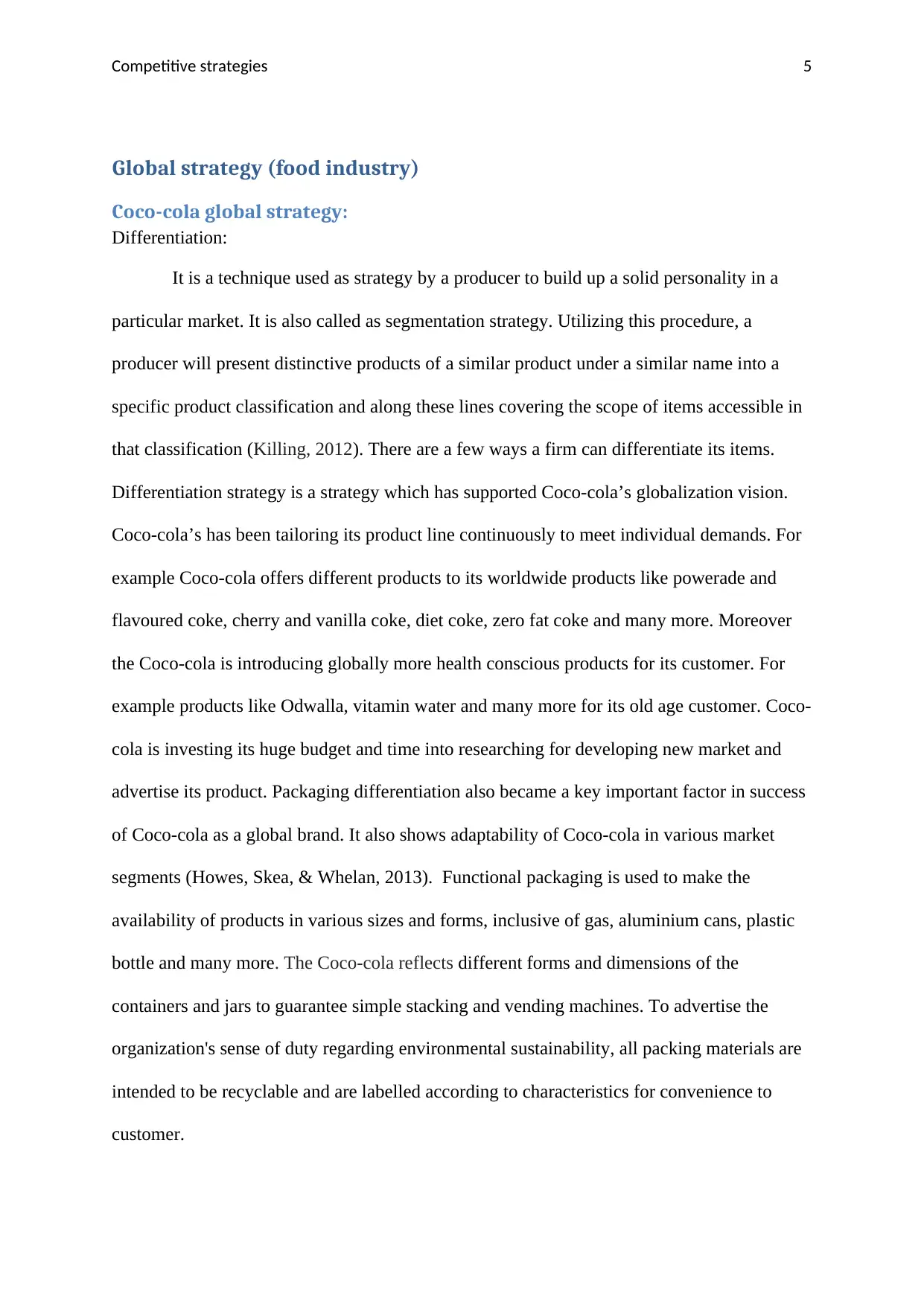
Competitive strategies 5
Global strategy (food industry)
Coco-cola global strategy:
Differentiation:
It is a technique used as strategy by a producer to build up a solid personality in a
particular market. It is also called as segmentation strategy. Utilizing this procedure, a
producer will present distinctive products of a similar product under a similar name into a
specific product classification and along these lines covering the scope of items accessible in
that classification (Killing, 2012). There are a few ways a firm can differentiate its items.
Differentiation strategy is a strategy which has supported Coco-cola’s globalization vision.
Coco-cola’s has been tailoring its product line continuously to meet individual demands. For
example Coco-cola offers different products to its worldwide products like powerade and
flavoured coke, cherry and vanilla coke, diet coke, zero fat coke and many more. Moreover
the Coco-cola is introducing globally more health conscious products for its customer. For
example products like Odwalla, vitamin water and many more for its old age customer. Coco-
cola is investing its huge budget and time into researching for developing new market and
advertise its product. Packaging differentiation also became a key important factor in success
of Coco-cola as a global brand. It also shows adaptability of Coco-cola in various market
segments (Howes, Skea, & Whelan, 2013). Functional packaging is used to make the
availability of products in various sizes and forms, inclusive of gas, aluminium cans, plastic
bottle and many more. The Coco-cola reflects different forms and dimensions of the
containers and jars to guarantee simple stacking and vending machines. To advertise the
organization's sense of duty regarding environmental sustainability, all packing materials are
intended to be recyclable and are labelled according to characteristics for convenience to
customer.
Global strategy (food industry)
Coco-cola global strategy:
Differentiation:
It is a technique used as strategy by a producer to build up a solid personality in a
particular market. It is also called as segmentation strategy. Utilizing this procedure, a
producer will present distinctive products of a similar product under a similar name into a
specific product classification and along these lines covering the scope of items accessible in
that classification (Killing, 2012). There are a few ways a firm can differentiate its items.
Differentiation strategy is a strategy which has supported Coco-cola’s globalization vision.
Coco-cola’s has been tailoring its product line continuously to meet individual demands. For
example Coco-cola offers different products to its worldwide products like powerade and
flavoured coke, cherry and vanilla coke, diet coke, zero fat coke and many more. Moreover
the Coco-cola is introducing globally more health conscious products for its customer. For
example products like Odwalla, vitamin water and many more for its old age customer. Coco-
cola is investing its huge budget and time into researching for developing new market and
advertise its product. Packaging differentiation also became a key important factor in success
of Coco-cola as a global brand. It also shows adaptability of Coco-cola in various market
segments (Howes, Skea, & Whelan, 2013). Functional packaging is used to make the
availability of products in various sizes and forms, inclusive of gas, aluminium cans, plastic
bottle and many more. The Coco-cola reflects different forms and dimensions of the
containers and jars to guarantee simple stacking and vending machines. To advertise the
organization's sense of duty regarding environmental sustainability, all packing materials are
intended to be recyclable and are labelled according to characteristics for convenience to
customer.
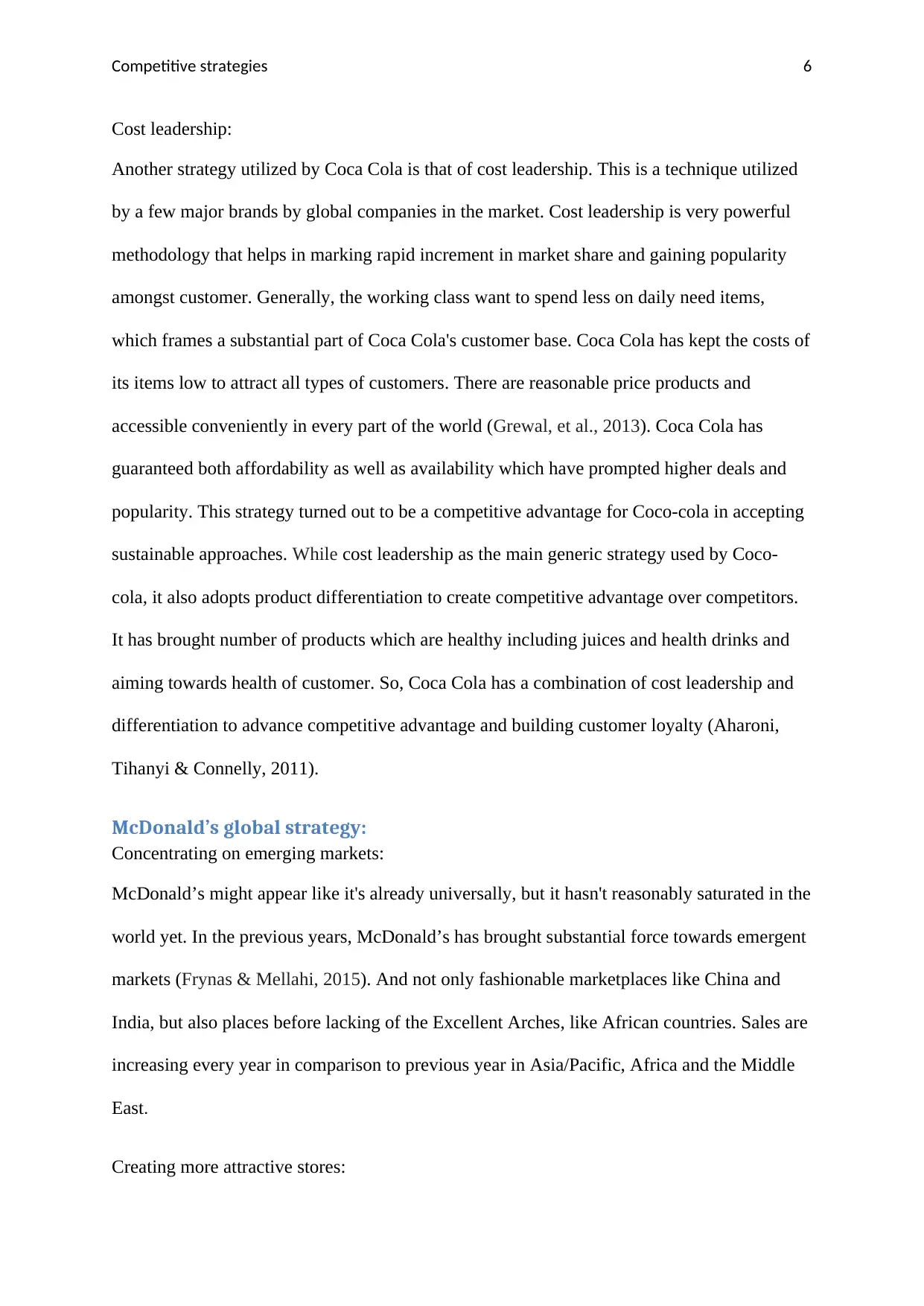
Competitive strategies 6
Cost leadership:
Another strategy utilized by Coca Cola is that of cost leadership. This is a technique utilized
by a few major brands by global companies in the market. Cost leadership is very powerful
methodology that helps in marking rapid increment in market share and gaining popularity
amongst customer. Generally, the working class want to spend less on daily need items,
which frames a substantial part of Coca Cola's customer base. Coca Cola has kept the costs of
its items low to attract all types of customers. There are reasonable price products and
accessible conveniently in every part of the world (Grewal, et al., 2013). Coca Cola has
guaranteed both affordability as well as availability which have prompted higher deals and
popularity. This strategy turned out to be a competitive advantage for Coco-cola in accepting
sustainable approaches. While cost leadership as the main generic strategy used by Coco-
cola, it also adopts product differentiation to create competitive advantage over competitors.
It has brought number of products which are healthy including juices and health drinks and
aiming towards health of customer. So, Coca Cola has a combination of cost leadership and
differentiation to advance competitive advantage and building customer loyalty (Aharoni,
Tihanyi & Connelly, 2011).
McDonald’s global strategy:
Concentrating on emerging markets:
McDonald’s might appear like it's already universally, but it hasn't reasonably saturated in the
world yet. In the previous years, McDonald’s has brought substantial force towards emergent
markets (Frynas & Mellahi, 2015). And not only fashionable marketplaces like China and
India, but also places before lacking of the Excellent Arches, like African countries. Sales are
increasing every year in comparison to previous year in Asia/Pacific, Africa and the Middle
East.
Creating more attractive stores:
Cost leadership:
Another strategy utilized by Coca Cola is that of cost leadership. This is a technique utilized
by a few major brands by global companies in the market. Cost leadership is very powerful
methodology that helps in marking rapid increment in market share and gaining popularity
amongst customer. Generally, the working class want to spend less on daily need items,
which frames a substantial part of Coca Cola's customer base. Coca Cola has kept the costs of
its items low to attract all types of customers. There are reasonable price products and
accessible conveniently in every part of the world (Grewal, et al., 2013). Coca Cola has
guaranteed both affordability as well as availability which have prompted higher deals and
popularity. This strategy turned out to be a competitive advantage for Coco-cola in accepting
sustainable approaches. While cost leadership as the main generic strategy used by Coco-
cola, it also adopts product differentiation to create competitive advantage over competitors.
It has brought number of products which are healthy including juices and health drinks and
aiming towards health of customer. So, Coca Cola has a combination of cost leadership and
differentiation to advance competitive advantage and building customer loyalty (Aharoni,
Tihanyi & Connelly, 2011).
McDonald’s global strategy:
Concentrating on emerging markets:
McDonald’s might appear like it's already universally, but it hasn't reasonably saturated in the
world yet. In the previous years, McDonald’s has brought substantial force towards emergent
markets (Frynas & Mellahi, 2015). And not only fashionable marketplaces like China and
India, but also places before lacking of the Excellent Arches, like African countries. Sales are
increasing every year in comparison to previous year in Asia/Pacific, Africa and the Middle
East.
Creating more attractive stores:
⊘ This is a preview!⊘
Do you want full access?
Subscribe today to unlock all pages.

Trusted by 1+ million students worldwide
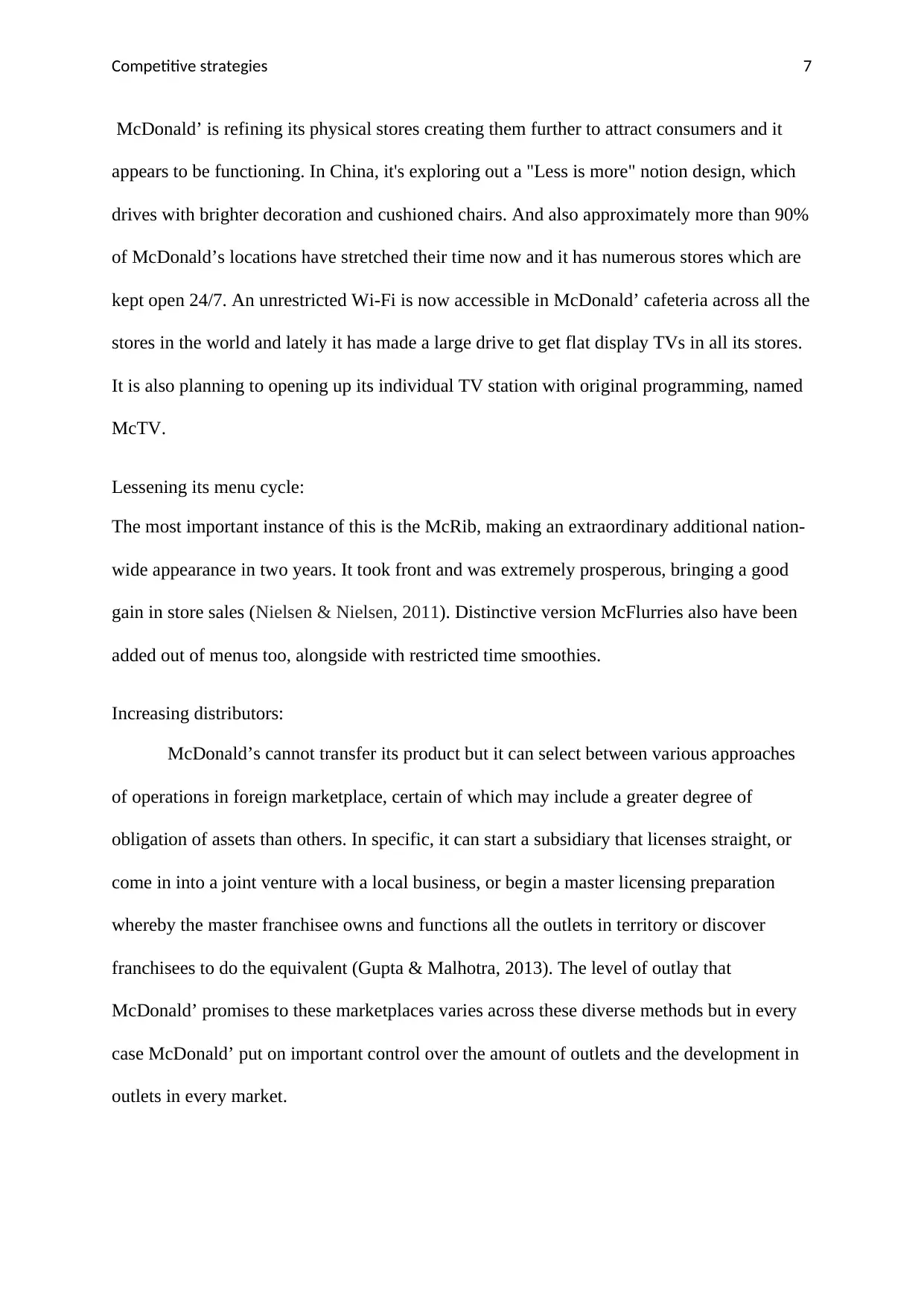
Competitive strategies 7
McDonald’ is refining its physical stores creating them further to attract consumers and it
appears to be functioning. In China, it's exploring out a "Less is more" notion design, which
drives with brighter decoration and cushioned chairs. And also approximately more than 90%
of McDonald’s locations have stretched their time now and it has numerous stores which are
kept open 24/7. An unrestricted Wi-Fi is now accessible in McDonald’ cafeteria across all the
stores in the world and lately it has made a large drive to get flat display TVs in all its stores.
It is also planning to opening up its individual TV station with original programming, named
McTV.
Lessening its menu cycle:
The most important instance of this is the McRib, making an extraordinary additional nation-
wide appearance in two years. It took front and was extremely prosperous, bringing a good
gain in store sales (Nielsen & Nielsen, 2011). Distinctive version McFlurries also have been
added out of menus too, alongside with restricted time smoothies.
Increasing distributors:
McDonald’s cannot transfer its product but it can select between various approaches
of operations in foreign marketplace, certain of which may include a greater degree of
obligation of assets than others. In specific, it can start a subsidiary that licenses straight, or
come in into a joint venture with a local business, or begin a master licensing preparation
whereby the master franchisee owns and functions all the outlets in territory or discover
franchisees to do the equivalent (Gupta & Malhotra, 2013). The level of outlay that
McDonald’ promises to these marketplaces varies across these diverse methods but in every
case McDonald’ put on important control over the amount of outlets and the development in
outlets in every market.
McDonald’ is refining its physical stores creating them further to attract consumers and it
appears to be functioning. In China, it's exploring out a "Less is more" notion design, which
drives with brighter decoration and cushioned chairs. And also approximately more than 90%
of McDonald’s locations have stretched their time now and it has numerous stores which are
kept open 24/7. An unrestricted Wi-Fi is now accessible in McDonald’ cafeteria across all the
stores in the world and lately it has made a large drive to get flat display TVs in all its stores.
It is also planning to opening up its individual TV station with original programming, named
McTV.
Lessening its menu cycle:
The most important instance of this is the McRib, making an extraordinary additional nation-
wide appearance in two years. It took front and was extremely prosperous, bringing a good
gain in store sales (Nielsen & Nielsen, 2011). Distinctive version McFlurries also have been
added out of menus too, alongside with restricted time smoothies.
Increasing distributors:
McDonald’s cannot transfer its product but it can select between various approaches
of operations in foreign marketplace, certain of which may include a greater degree of
obligation of assets than others. In specific, it can start a subsidiary that licenses straight, or
come in into a joint venture with a local business, or begin a master licensing preparation
whereby the master franchisee owns and functions all the outlets in territory or discover
franchisees to do the equivalent (Gupta & Malhotra, 2013). The level of outlay that
McDonald’ promises to these marketplaces varies across these diverse methods but in every
case McDonald’ put on important control over the amount of outlets and the development in
outlets in every market.
Paraphrase This Document
Need a fresh take? Get an instant paraphrase of this document with our AI Paraphraser
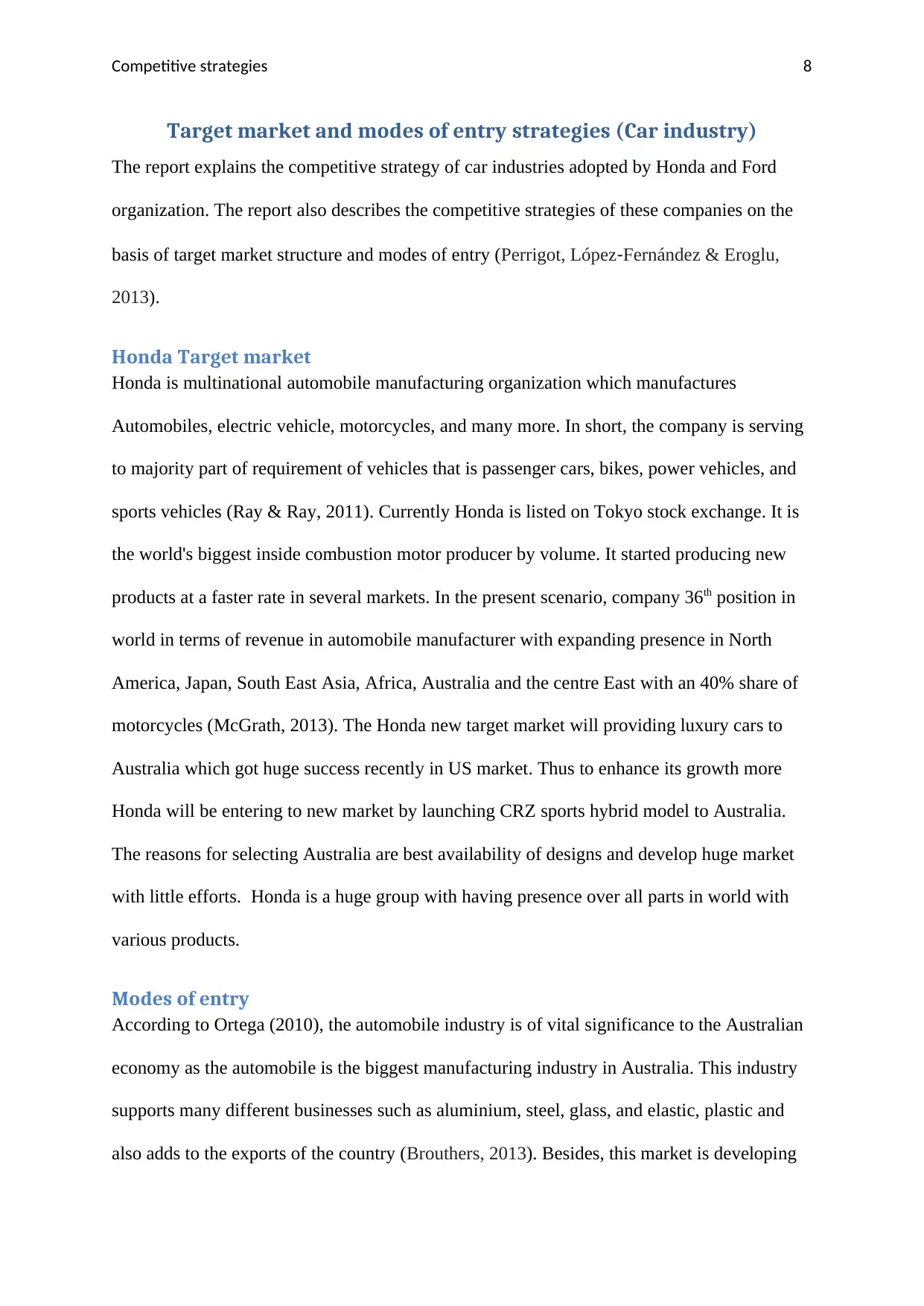
Competitive strategies 8
Target market and modes of entry strategies (Car industry)
The report explains the competitive strategy of car industries adopted by Honda and Ford
organization. The report also describes the competitive strategies of these companies on the
basis of target market structure and modes of entry (Perrigot, López‐Fernández & Eroglu,
2013).
Honda Target market
Honda is multinational automobile manufacturing organization which manufactures
Automobiles, electric vehicle, motorcycles, and many more. In short, the company is serving
to majority part of requirement of vehicles that is passenger cars, bikes, power vehicles, and
sports vehicles (Ray & Ray, 2011). Currently Honda is listed on Tokyo stock exchange. It is
the world's biggest inside combustion motor producer by volume. It started producing new
products at a faster rate in several markets. In the present scenario, company 36th position in
world in terms of revenue in automobile manufacturer with expanding presence in North
America, Japan, South East Asia, Africa, Australia and the centre East with an 40% share of
motorcycles (McGrath, 2013). The Honda new target market will providing luxury cars to
Australia which got huge success recently in US market. Thus to enhance its growth more
Honda will be entering to new market by launching CRZ sports hybrid model to Australia.
The reasons for selecting Australia are best availability of designs and develop huge market
with little efforts. Honda is a huge group with having presence over all parts in world with
various products.
Modes of entry
According to Ortega (2010), the automobile industry is of vital significance to the Australian
economy as the automobile is the biggest manufacturing industry in Australia. This industry
supports many different businesses such as aluminium, steel, glass, and elastic, plastic and
also adds to the exports of the country (Brouthers, 2013). Besides, this market is developing
Target market and modes of entry strategies (Car industry)
The report explains the competitive strategy of car industries adopted by Honda and Ford
organization. The report also describes the competitive strategies of these companies on the
basis of target market structure and modes of entry (Perrigot, López‐Fernández & Eroglu,
2013).
Honda Target market
Honda is multinational automobile manufacturing organization which manufactures
Automobiles, electric vehicle, motorcycles, and many more. In short, the company is serving
to majority part of requirement of vehicles that is passenger cars, bikes, power vehicles, and
sports vehicles (Ray & Ray, 2011). Currently Honda is listed on Tokyo stock exchange. It is
the world's biggest inside combustion motor producer by volume. It started producing new
products at a faster rate in several markets. In the present scenario, company 36th position in
world in terms of revenue in automobile manufacturer with expanding presence in North
America, Japan, South East Asia, Africa, Australia and the centre East with an 40% share of
motorcycles (McGrath, 2013). The Honda new target market will providing luxury cars to
Australia which got huge success recently in US market. Thus to enhance its growth more
Honda will be entering to new market by launching CRZ sports hybrid model to Australia.
The reasons for selecting Australia are best availability of designs and develop huge market
with little efforts. Honda is a huge group with having presence over all parts in world with
various products.
Modes of entry
According to Ortega (2010), the automobile industry is of vital significance to the Australian
economy as the automobile is the biggest manufacturing industry in Australia. This industry
supports many different businesses such as aluminium, steel, glass, and elastic, plastic and
also adds to the exports of the country (Brouthers, 2013). Besides, this market is developing
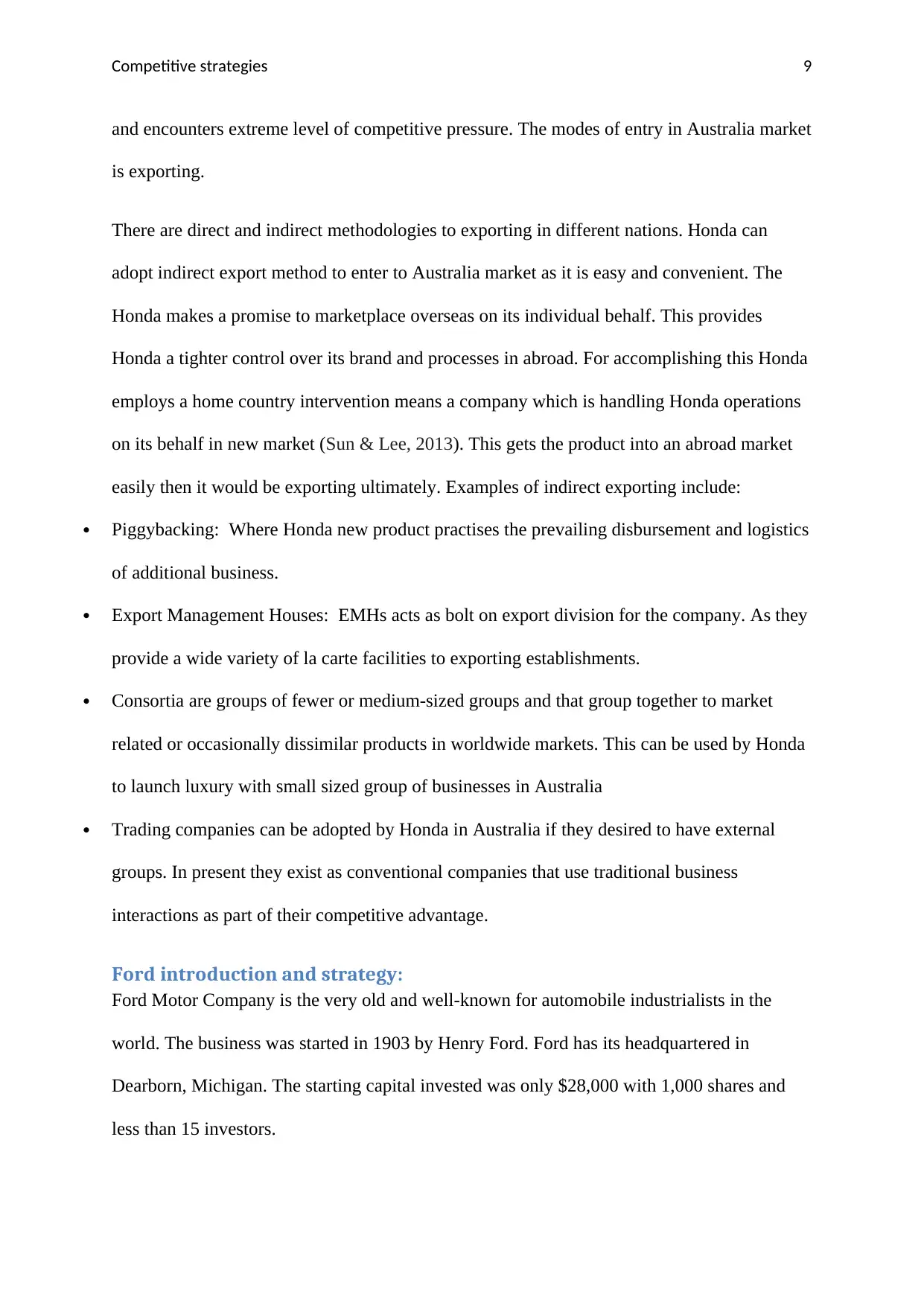
Competitive strategies 9
and encounters extreme level of competitive pressure. The modes of entry in Australia market
is exporting.
There are direct and indirect methodologies to exporting in different nations. Honda can
adopt indirect export method to enter to Australia market as it is easy and convenient. The
Honda makes a promise to marketplace overseas on its individual behalf. This provides
Honda a tighter control over its brand and processes in abroad. For accomplishing this Honda
employs a home country intervention means a company which is handling Honda operations
on its behalf in new market (Sun & Lee, 2013). This gets the product into an abroad market
easily then it would be exporting ultimately. Examples of indirect exporting include:
Piggybacking: Where Honda new product practises the prevailing disbursement and logistics
of additional business.
Export Management Houses: EMHs acts as bolt on export division for the company. As they
provide a wide variety of la carte facilities to exporting establishments.
Consortia are groups of fewer or medium-sized groups and that group together to market
related or occasionally dissimilar products in worldwide markets. This can be used by Honda
to launch luxury with small sized group of businesses in Australia
Trading companies can be adopted by Honda in Australia if they desired to have external
groups. In present they exist as conventional companies that use traditional business
interactions as part of their competitive advantage.
Ford introduction and strategy:
Ford Motor Company is the very old and well-known for automobile industrialists in the
world. The business was started in 1903 by Henry Ford. Ford has its headquartered in
Dearborn, Michigan. The starting capital invested was only $28,000 with 1,000 shares and
less than 15 investors.
and encounters extreme level of competitive pressure. The modes of entry in Australia market
is exporting.
There are direct and indirect methodologies to exporting in different nations. Honda can
adopt indirect export method to enter to Australia market as it is easy and convenient. The
Honda makes a promise to marketplace overseas on its individual behalf. This provides
Honda a tighter control over its brand and processes in abroad. For accomplishing this Honda
employs a home country intervention means a company which is handling Honda operations
on its behalf in new market (Sun & Lee, 2013). This gets the product into an abroad market
easily then it would be exporting ultimately. Examples of indirect exporting include:
Piggybacking: Where Honda new product practises the prevailing disbursement and logistics
of additional business.
Export Management Houses: EMHs acts as bolt on export division for the company. As they
provide a wide variety of la carte facilities to exporting establishments.
Consortia are groups of fewer or medium-sized groups and that group together to market
related or occasionally dissimilar products in worldwide markets. This can be used by Honda
to launch luxury with small sized group of businesses in Australia
Trading companies can be adopted by Honda in Australia if they desired to have external
groups. In present they exist as conventional companies that use traditional business
interactions as part of their competitive advantage.
Ford introduction and strategy:
Ford Motor Company is the very old and well-known for automobile industrialists in the
world. The business was started in 1903 by Henry Ford. Ford has its headquartered in
Dearborn, Michigan. The starting capital invested was only $28,000 with 1,000 shares and
less than 15 investors.
⊘ This is a preview!⊘
Do you want full access?
Subscribe today to unlock all pages.

Trusted by 1+ million students worldwide
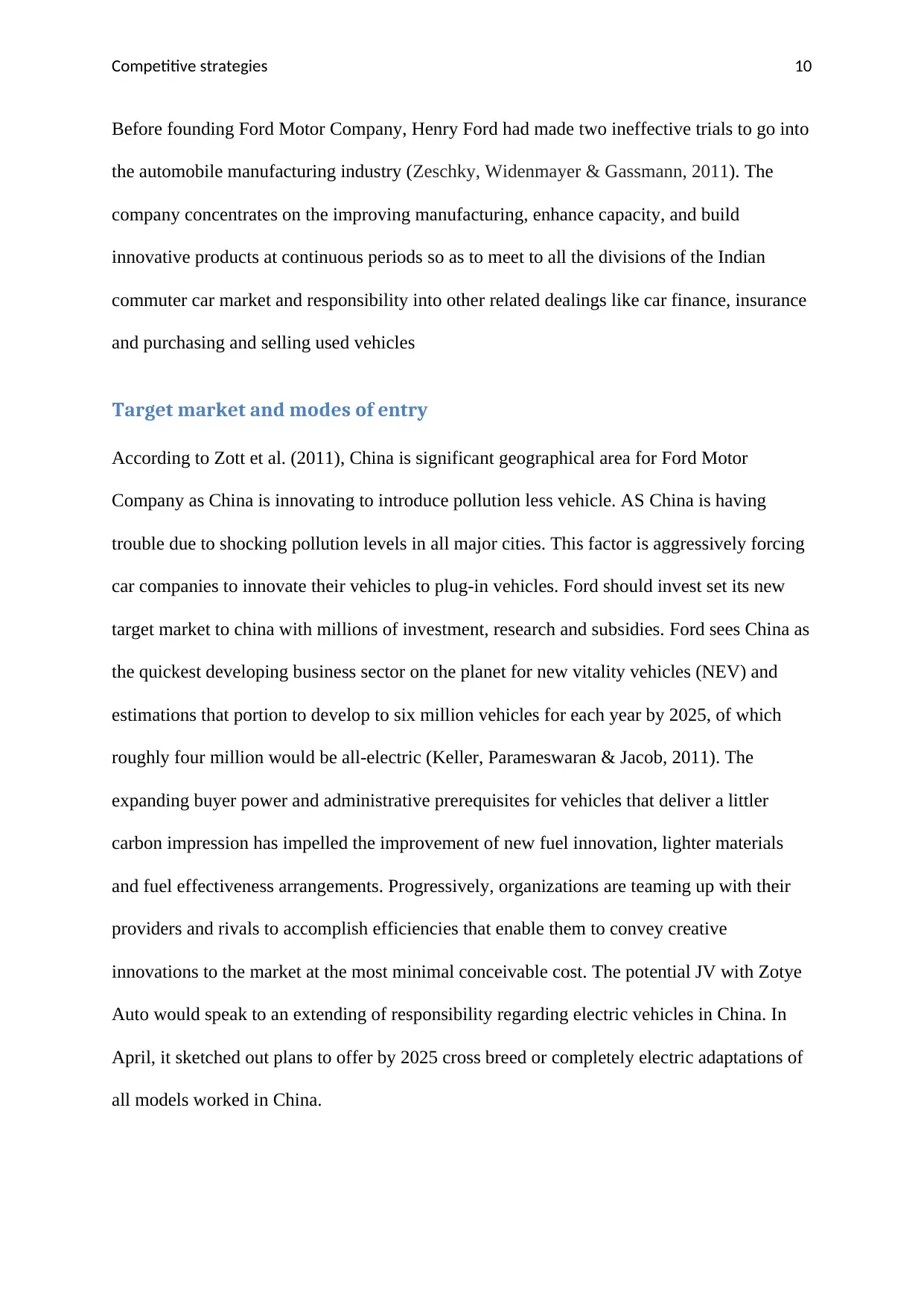
Competitive strategies 10
Before founding Ford Motor Company, Henry Ford had made two ineffective trials to go into
the automobile manufacturing industry (Zeschky, Widenmayer & Gassmann, 2011). The
company concentrates on the improving manufacturing, enhance capacity, and build
innovative products at continuous periods so as to meet to all the divisions of the Indian
commuter car market and responsibility into other related dealings like car finance, insurance
and purchasing and selling used vehicles
Target market and modes of entry
According to Zott et al. (2011), China is significant geographical area for Ford Motor
Company as China is innovating to introduce pollution less vehicle. AS China is having
trouble due to shocking pollution levels in all major cities. This factor is aggressively forcing
car companies to innovate their vehicles to plug-in vehicles. Ford should invest set its new
target market to china with millions of investment, research and subsidies. Ford sees China as
the quickest developing business sector on the planet for new vitality vehicles (NEV) and
estimations that portion to develop to six million vehicles for each year by 2025, of which
roughly four million would be all-electric (Keller, Parameswaran & Jacob, 2011). The
expanding buyer power and administrative prerequisites for vehicles that deliver a littler
carbon impression has impelled the improvement of new fuel innovation, lighter materials
and fuel effectiveness arrangements. Progressively, organizations are teaming up with their
providers and rivals to accomplish efficiencies that enable them to convey creative
innovations to the market at the most minimal conceivable cost. The potential JV with Zotye
Auto would speak to an extending of responsibility regarding electric vehicles in China. In
April, it sketched out plans to offer by 2025 cross breed or completely electric adaptations of
all models worked in China.
Before founding Ford Motor Company, Henry Ford had made two ineffective trials to go into
the automobile manufacturing industry (Zeschky, Widenmayer & Gassmann, 2011). The
company concentrates on the improving manufacturing, enhance capacity, and build
innovative products at continuous periods so as to meet to all the divisions of the Indian
commuter car market and responsibility into other related dealings like car finance, insurance
and purchasing and selling used vehicles
Target market and modes of entry
According to Zott et al. (2011), China is significant geographical area for Ford Motor
Company as China is innovating to introduce pollution less vehicle. AS China is having
trouble due to shocking pollution levels in all major cities. This factor is aggressively forcing
car companies to innovate their vehicles to plug-in vehicles. Ford should invest set its new
target market to china with millions of investment, research and subsidies. Ford sees China as
the quickest developing business sector on the planet for new vitality vehicles (NEV) and
estimations that portion to develop to six million vehicles for each year by 2025, of which
roughly four million would be all-electric (Keller, Parameswaran & Jacob, 2011). The
expanding buyer power and administrative prerequisites for vehicles that deliver a littler
carbon impression has impelled the improvement of new fuel innovation, lighter materials
and fuel effectiveness arrangements. Progressively, organizations are teaming up with their
providers and rivals to accomplish efficiencies that enable them to convey creative
innovations to the market at the most minimal conceivable cost. The potential JV with Zotye
Auto would speak to an extending of responsibility regarding electric vehicles in China. In
April, it sketched out plans to offer by 2025 cross breed or completely electric adaptations of
all models worked in China.
Paraphrase This Document
Need a fresh take? Get an instant paraphrase of this document with our AI Paraphraser
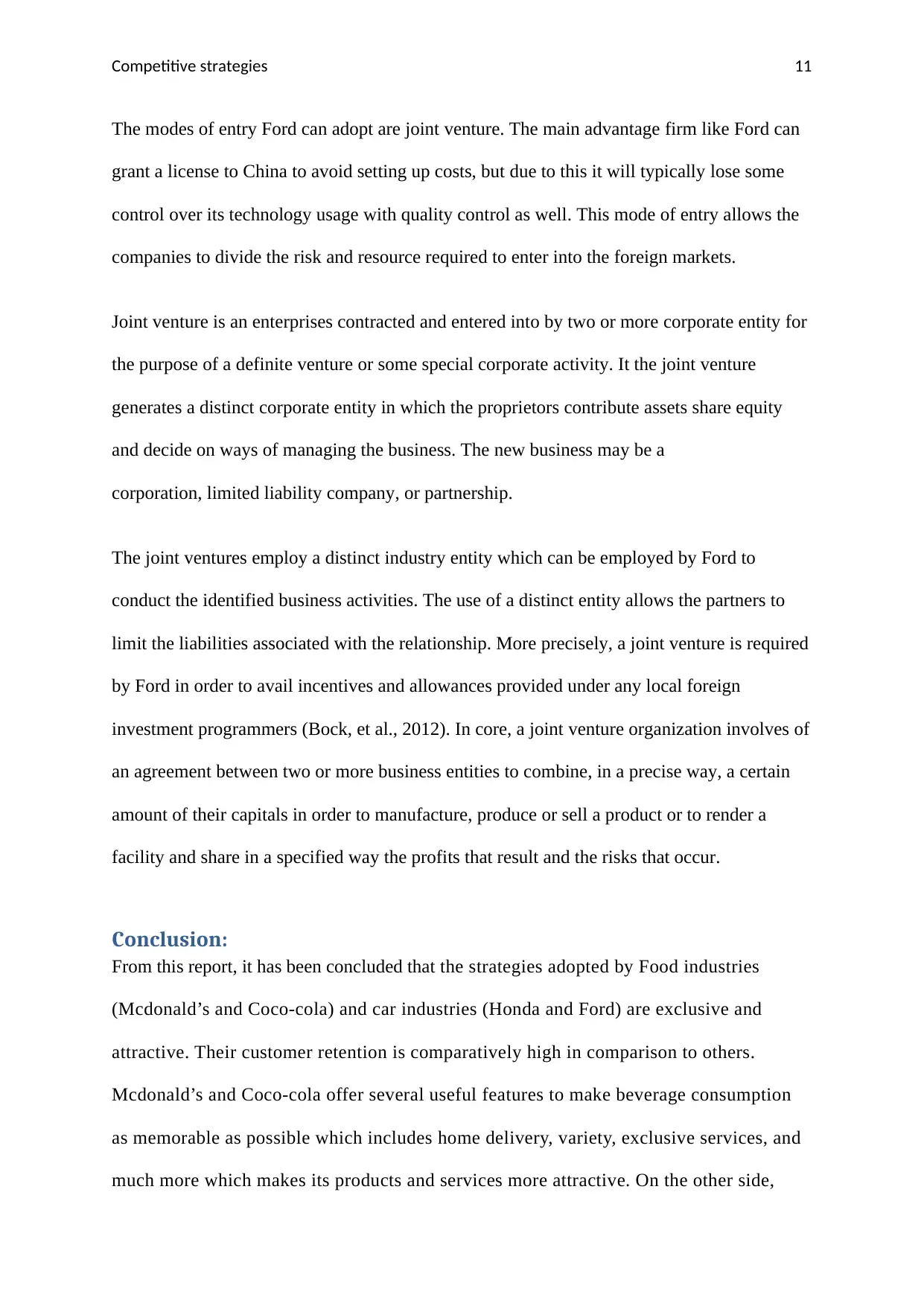
Competitive strategies 11
The modes of entry Ford can adopt are joint venture. The main advantage firm like Ford can
grant a license to China to avoid setting up costs, but due to this it will typically lose some
control over its technology usage with quality control as well. This mode of entry allows the
companies to divide the risk and resource required to enter into the foreign markets.
Joint venture is an enterprises contracted and entered into by two or more corporate entity for
the purpose of a definite venture or some special corporate activity. It the joint venture
generates a distinct corporate entity in which the proprietors contribute assets share equity
and decide on ways of managing the business. The new business may be a
corporation, limited liability company, or partnership.
The joint ventures employ a distinct industry entity which can be employed by Ford to
conduct the identified business activities. The use of a distinct entity allows the partners to
limit the liabilities associated with the relationship. More precisely, a joint venture is required
by Ford in order to avail incentives and allowances provided under any local foreign
investment programmers (Bock, et al., 2012). In core, a joint venture organization involves of
an agreement between two or more business entities to combine, in a precise way, a certain
amount of their capitals in order to manufacture, produce or sell a product or to render a
facility and share in a specified way the profits that result and the risks that occur.
Conclusion:
From this report, it has been concluded that the strategies adopted by Food industries
(Mcdonald’s and Coco-cola) and car industries (Honda and Ford) are exclusive and
attractive. Their customer retention is comparatively high in comparison to others.
Mcdonald’s and Coco-cola offer several useful features to make beverage consumption
as memorable as possible which includes home delivery, variety, exclusive services, and
much more which makes its products and services more attractive. On the other side,
The modes of entry Ford can adopt are joint venture. The main advantage firm like Ford can
grant a license to China to avoid setting up costs, but due to this it will typically lose some
control over its technology usage with quality control as well. This mode of entry allows the
companies to divide the risk and resource required to enter into the foreign markets.
Joint venture is an enterprises contracted and entered into by two or more corporate entity for
the purpose of a definite venture or some special corporate activity. It the joint venture
generates a distinct corporate entity in which the proprietors contribute assets share equity
and decide on ways of managing the business. The new business may be a
corporation, limited liability company, or partnership.
The joint ventures employ a distinct industry entity which can be employed by Ford to
conduct the identified business activities. The use of a distinct entity allows the partners to
limit the liabilities associated with the relationship. More precisely, a joint venture is required
by Ford in order to avail incentives and allowances provided under any local foreign
investment programmers (Bock, et al., 2012). In core, a joint venture organization involves of
an agreement between two or more business entities to combine, in a precise way, a certain
amount of their capitals in order to manufacture, produce or sell a product or to render a
facility and share in a specified way the profits that result and the risks that occur.
Conclusion:
From this report, it has been concluded that the strategies adopted by Food industries
(Mcdonald’s and Coco-cola) and car industries (Honda and Ford) are exclusive and
attractive. Their customer retention is comparatively high in comparison to others.
Mcdonald’s and Coco-cola offer several useful features to make beverage consumption
as memorable as possible which includes home delivery, variety, exclusive services, and
much more which makes its products and services more attractive. On the other side,
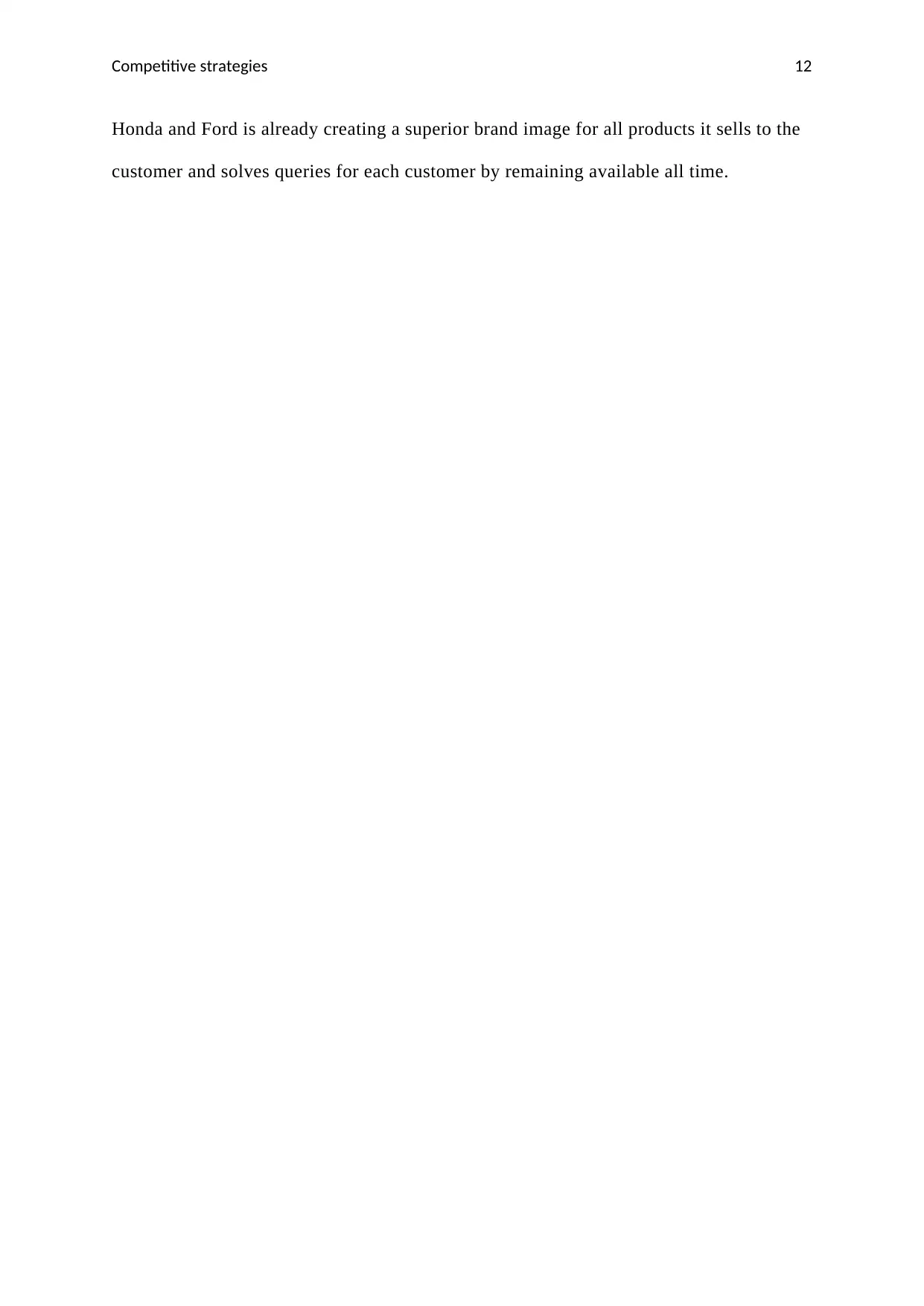
Competitive strategies 12
Honda and Ford is already creating a superior brand image for all products it sells to the
customer and solves queries for each customer by remaining available all time.
Honda and Ford is already creating a superior brand image for all products it sells to the
customer and solves queries for each customer by remaining available all time.
⊘ This is a preview!⊘
Do you want full access?
Subscribe today to unlock all pages.

Trusted by 1+ million students worldwide
1 out of 15
Related Documents
Your All-in-One AI-Powered Toolkit for Academic Success.
+13062052269
info@desklib.com
Available 24*7 on WhatsApp / Email
![[object Object]](/_next/static/media/star-bottom.7253800d.svg)
Unlock your academic potential
Copyright © 2020–2025 A2Z Services. All Rights Reserved. Developed and managed by ZUCOL.





